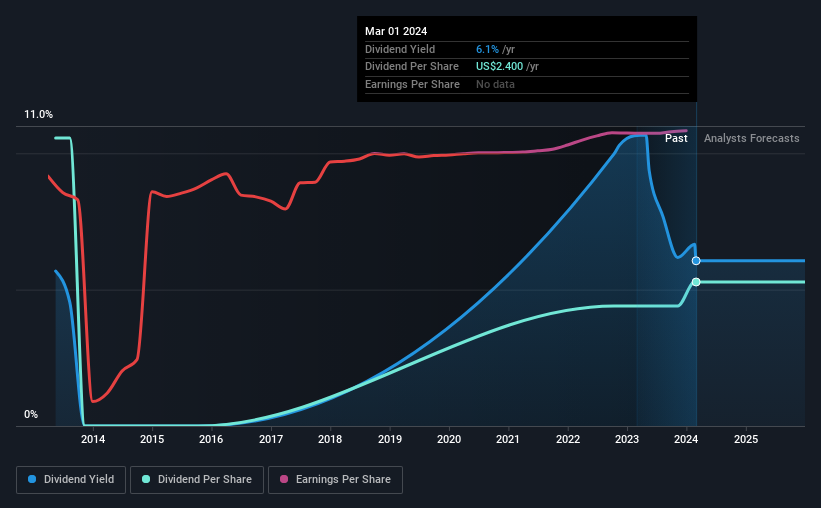There's A Lot To Like About Euroseas' (NASDAQ:ESEA) Upcoming US$0.60 Dividend
Some investors rely on dividends for growing their wealth, and if you're one of those dividend sleuths, you might be intrigued to know that Euroseas Ltd. (NASDAQ:ESEA) is about to go ex-dividend in just 4 days. Typically, the ex-dividend date is one business day before the record date which is the date on which a company determines the shareholders eligible to receive a dividend. The ex-dividend date is an important date to be aware of as any purchase of the stock made on or after this date might mean a late settlement that doesn't show on the record date. This means that investors who purchase Euroseas' shares on or after the 7th of March will not receive the dividend, which will be paid on the 15th of March.
The company's next dividend payment will be US$0.60 per share, on the back of last year when the company paid a total of US$2.40 to shareholders. Based on the last year's worth of payments, Euroseas stock has a trailing yield of around 6.1% on the current share price of US$39.62. Dividends are an important source of income to many shareholders, but the health of the business is crucial to maintaining those dividends. So we need to investigate whether Euroseas can afford its dividend, and if the dividend could grow.
Check out our latest analysis for Euroseas
Dividends are usually paid out of company profits, so if a company pays out more than it earned then its dividend is usually at greater risk of being cut. Euroseas paid out just 13% of its profit last year, which we think is conservatively low and leaves plenty of margin for unexpected circumstances. A useful secondary check can be to evaluate whether Euroseas generated enough free cash flow to afford its dividend. It paid out 79% of its free cash flow as dividends, which is within usual limits but will limit the company's ability to lift the dividend if there's no growth.
It's encouraging to see that the dividend is covered by both profit and cash flow. This generally suggests the dividend is sustainable, as long as earnings don't drop precipitously.
Click here to see the company's payout ratio, plus analyst estimates of its future dividends.
Have Earnings And Dividends Been Growing?
Businesses with strong growth prospects usually make the best dividend payers, because it's easier to grow dividends when earnings per share are improving. Investors love dividends, so if earnings fall and the dividend is reduced, expect a stock to be sold off heavily at the same time. It's encouraging to see Euroseas has grown its earnings rapidly, up 68% a year for the past five years.
Another key way to measure a company's dividend prospects is by measuring its historical rate of dividend growth. Euroseas's dividend payments per share have declined at 6.7% per year on average over the past 10 years, which is uninspiring. It's unusual to see earnings per share increasing at the same time as dividends per share have been in decline. We'd hope it's because the company is reinvesting heavily in its business, but it could also suggest business is lumpy.
To Sum It Up
Should investors buy Euroseas for the upcoming dividend? From a dividend perspective, we're encouraged to see that earnings per share have been growing, the company is paying out less than half of its earnings, and a bit over half its free cash flow. Euroseas looks solid on this analysis overall, and we'd definitely consider investigating it more closely.
In light of that, while Euroseas has an appealing dividend, it's worth knowing the risks involved with this stock. For example, Euroseas has 3 warning signs (and 2 which are potentially serious) we think you should know about.
Generally, we wouldn't recommend just buying the first dividend stock you see. Here's a curated list of interesting stocks that are strong dividend payers.
Have feedback on this article? Concerned about the content? Get in touch with us directly. Alternatively, email editorial-team (at) simplywallst.com.
This article by Simply Wall St is general in nature. We provide commentary based on historical data and analyst forecasts only using an unbiased methodology and our articles are not intended to be financial advice. It does not constitute a recommendation to buy or sell any stock, and does not take account of your objectives, or your financial situation. We aim to bring you long-term focused analysis driven by fundamental data. Note that our analysis may not factor in the latest price-sensitive company announcements or qualitative material. Simply Wall St has no position in any stocks mentioned.

